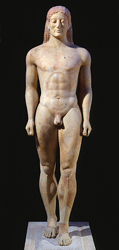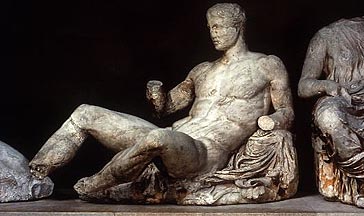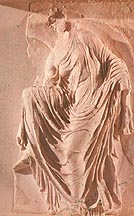Art Home | ARTH Courses | ARTH 200 Assignments
Female Figure in Archaic and Classical Greek Art
In our discussion of the beginnings of monumental stone sculpture in Greek art, we noted the central position of the standing male nude or kouros figure in the development of Archaic art. Contemporaneous to the kouros figure, there developed the female or kore (pl: korai) figure. The one illustrated above was a votive dedication made about 520 BCE on the Acropolis in Athens. Nanette Salomon in her article on the Venus Pudica pose has succinctly articulated the contrast between the Kouros and Kore figures: "The male figure is portrayed as coherent and rational from within; the female figure is portrayed as attractive from without; the male figure is dynamically explored as an internally logical, organic unity; the female body is treated as an external surface decoration."
Much of the development of archaic kouroi figures revolves around the increasing information the artists record about the muscles and skeletal structure of the male figure. In contrast, the elaborate clothing of the kore figure hides the body underneath. The artist's focus is directed to the elaborate patterns of the drapery and hair. One is analytical and the other is decorative.
The different approaches to male and female figures in Greek art reflect the profound imbalance between the sexes in social, economic, and legal practices of the period. To be a citizen of a polis was central to a Greek's identity, and citizenship was open only to free, adult males. While necessary to be included in the Greek polis, the female was excluded from citizenship. The female was understood as the other and the antithesis of the free male citizen. This fitted into the Greek's seeing the world through the perspective of a series of binaries or antinomies: Greek / barbarian, male /female, free/slave, human/ animal. These antinomies established the privileged position of the Greek male. The nudity of the male in Greek art was a sign for the male citizen. It reflected the known regular practice of young men exercising in the gymnasium in the nude, while women were always discretely covered in public. Likewise the nudity of the Greek male was understood as a contrast to men in other ancient societies who would have been deemed barbaric by the Greeks.
In your journal compare the reclining male and female figures from the East Pediment of the Parthenon:





